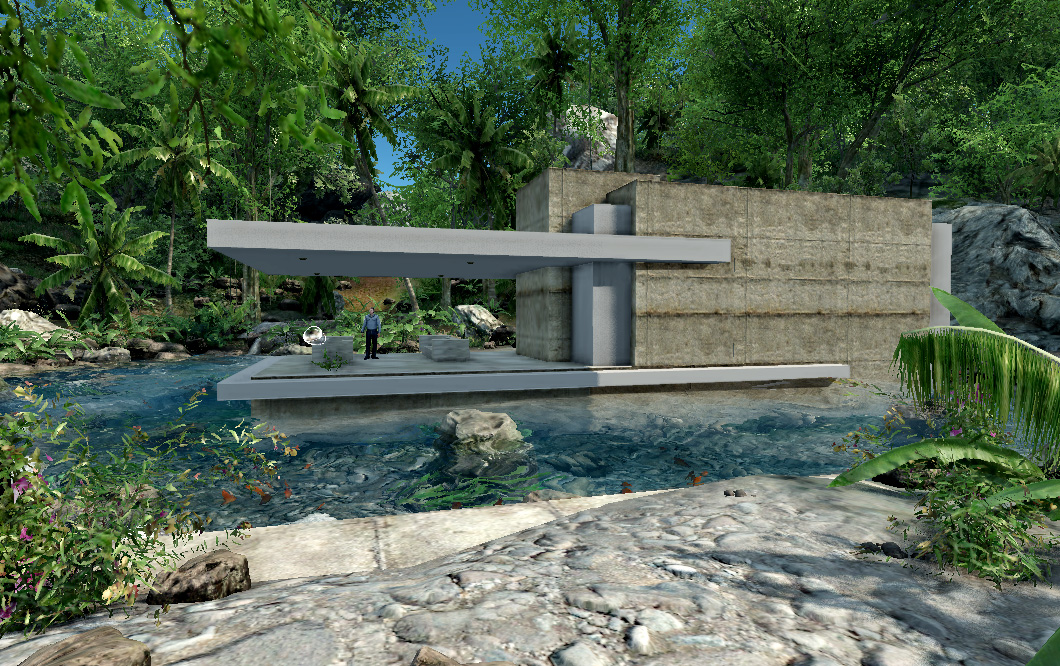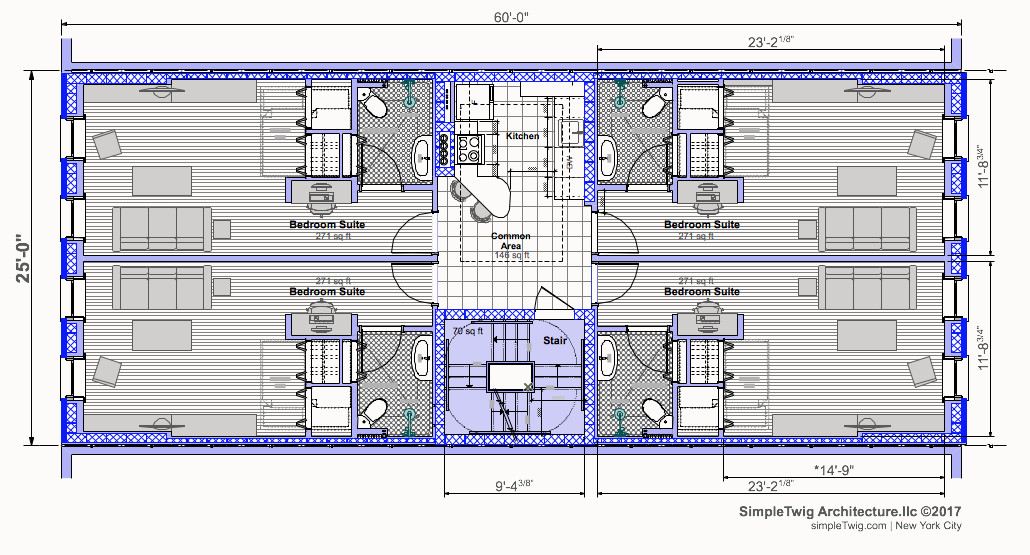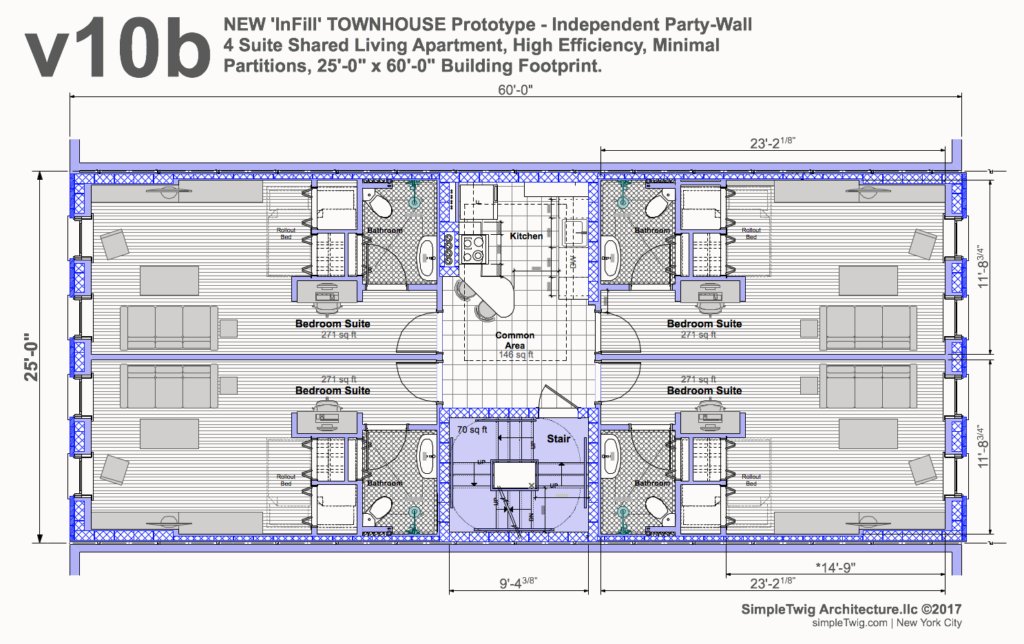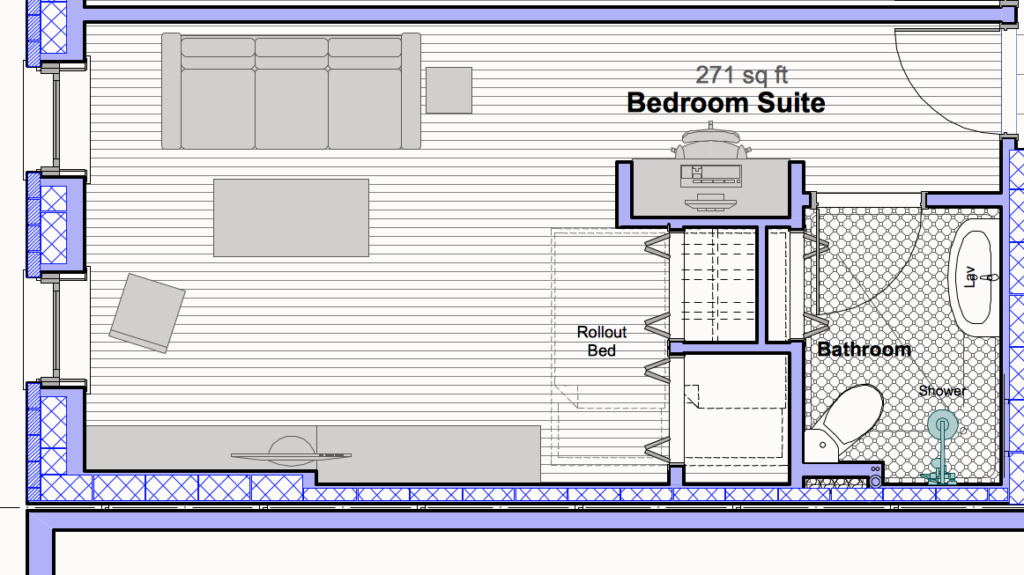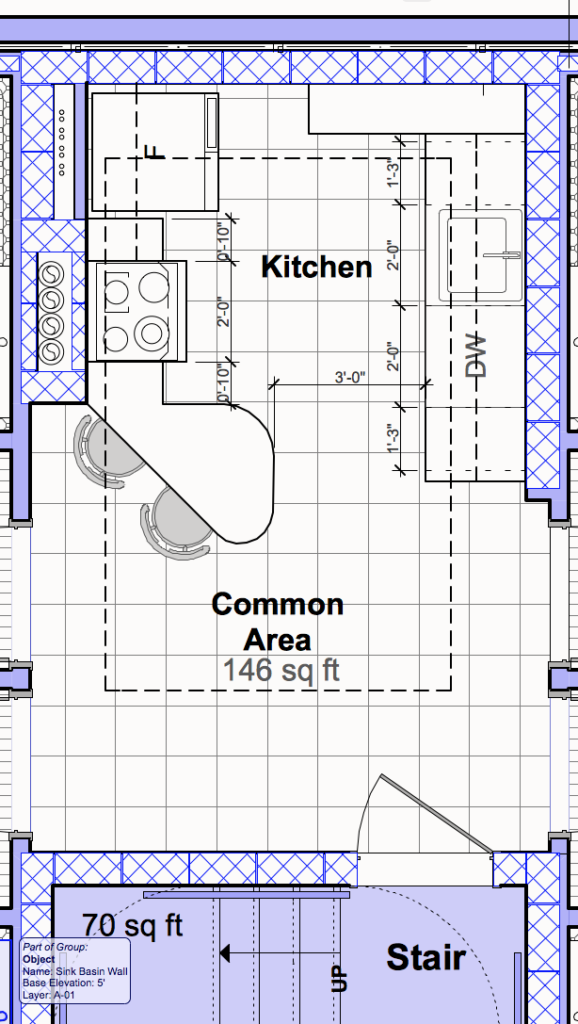This version is for the smaller walkup building of 25’x60′ in order to fit the programmatic components comfortably. It provides a way for a developer to accommodate more people within a building footprint and thus increase the yearly income.
The concept is simple, take what would normally be a three bedroom apartment and change it to 4 shared living suites where individuals get their own private suite, complete with a private bathroom, bedroom and living space, and then share only the kitchen and other building amenities. For a 5 story walkup, the potential is for 19 ‘bedroom suites’ versus the conventional 5-3 bedroom apartments. It is simple math from this point to understand that the suites are occupied with working adults while 2/3’s of the bedrooms from a standard apartment are occupied by children, or, that home office.
While I am not advocating removing regular apartments from the housing stock of New York City, it is abundantly clear that there are millions of single people who need affordable housing, many of them want the location over the quality of the apartment, that is, they want to be close to the ‘action’ and if possible as close to or within the heart of Manhattan. Why? They live outdoors with their interaction in the life of the city.
And here is the floor plan, version 10b, part of a long series of housing floor plans we are doing, each addressing specific needs, footprints, end users and owners. This one, as mentioned is for the developer with higher outlay but bigger return: the individual bathrooms and pull-out bed/closet system costing more up front and thus making it ‘out of reach’ for most single property homeowners. The advantage is the slightly higher rent that can be charged by the developer and the slightly longer wait for return. That return, being real money in the bank far out pacing the single property homeowner’s income and thus a more stable financial approach, but ‘you need money to make money’ as the saying goes.
Here the developer lays out extra money for the construction of the project, and then promotes each suite as an independent entity, with a shared kitchen and other amenities. Legally each floor is considered a single apartment with roommates, but the differences end there. Whether the tenants what a shared community, or to just lock themselves in their own suite, the real advantage is privacy, security and price in a great location, all helping the property owner afford the nicer new building and property cost for the project. It really is a win win situation.
THE SUITE
The ‘magic’ of the suites is the pull out bed, allowing the tenant to make their bed in the mornings and roll it under a closet/storage unit thus freeing up the room for daily living. When put away, the living area is quite large and typical of most apartments, all for one person.
Embedded in this storage construct is a built-in desk and shelf area, handing when entering or leaving the apartment, it doubles to help keep the apartment tidy and spacious feeling.
The bathroom, while compact provides everything an individual could hope for in a small apartment. There is a toiletry closet, a lavatory, toilet and rain shower with an additional handheld shower head. In fact, to save space the entire room is the shower.
A few well placed built-ins complete this suite, including the TV cabinet, the Desk and shelving and the storage/closet area.
All suites are identical, making for faster construction. Each suite has access to laundry and private and secure storage in the cellar, helping make this a place to stay. The extra storage in the cellar, helps tenants keep their small suites well organized and tidy, so they don’t feel they’ve outgrown the space and will thus tend to stay longer.
KITCHEN AND COMMON AREA
While small, to help make the suites larger, the kitchen offers secured cabinets, one for each suite, so that people can feel their food items, dishes, etc. are secure, thus helping avoid any conflicts in the apartment.
There is an extended countertop for ‘quick breakfasts’ or just to sit and chat with someone cooking. And here is the opportunity for shared living, to come out and interact around food, to cook together, one preparing a salad while the other makes the spaghetti, it’s all about making the most of this great city and being a part of something special.
A built-in microwave, vented to the exterior hood, dishwasher, large sink (single to encourage it to be kept empty), and a reasonably sized refrigerator make up the list of appliances, coupled with adequate cabinet storage space for 4 people.
The kitchen comes with a raised ceiling, thus creating lower ceilings that are acoustically treated around the ‘front door’ and each suite door, creating a slight separation without taking up valuable space.
ROOF TERRACE & BACKYARD
A roof terrace completes the building and provides welcome extra light, air and space for the tenants, encouraging interaction and a happy place to live. With the stack and stair location near the edges of the party-wall, the terrace itself is large and open, with built-in seating on both ends, and some plantings especially if in direct sunlight. The exit from the stair would feature a small glass enclosure over looking both halves of the terrace, and perhaps a small trellis on the back half to provide some privacy from surrounding buildings, thus providing the opportunity to have two distinct characters to each terrace, the front being more open for larger gatherings and the back being design to reflect an intimate garden oasis.
SUMMARY
- COMPARISON to PREVIOUS VERSION STUDIES BY SIMPLETWIG ARCHITECTURE:
- Utilizing layout similar to a hotel suite, but with a kitchen, this design isn’t about beautiful design, it is about practicality. There are tens of thousands of people in NYC living in shoe boxes, this seeks to provide nice suites for those people. This prototype concept provides the ability to live in a descent sized living environment that provides space, privacy and plenty of daylight. Essentially a self-contained apartment within an apartment.
- For the Developer, the concern is not focused on overspending for extra plumbing fixtures, but for maximizing the return over a longer period of time. This means more semi-apartments within a building footprint yielding more monthly income, and a design layout that will attract tenants.
- To put it in terms of rent, this sized unit could be a 3 bedroom standard apartment, due in part to the available windows for the Living Room and Bedrooms, a code requirement. As such, and for comparison, lets say this apartment could command $3500/month. As a four suite apartment each suite could command $1200/month, yielding $4800/month for the same footprint. That’s a difference, over a 10 year period, of collecting $420,000 versus $576,000. Clearly if one has the money to invest this is a direction one should strongly consider.
- FEATURES
- Providing a kitchen (within the unit) and laundry to tenants gives them the amenities they need without costing the developer extra up-front money. In other words, if in this footprint there were 4 separate apartments each would require 3 additional kitchens. This also translates into lower rents because of lower construction costs.
- Laundry is shared laundry for an entire building.
- Storage: Fire-proof and lockable storage units are available to each suite, allowing people to store larger items without having those things clutter up the apartment.
- Regarding the Kitchen: Gas Range, Refrigerator, Sink, Microwave, Vented Hood, Dishwasher and plenty of countertop space. There is a floor to ceiling pantry where each person can lock up their personal food items. It should be understood that single people are more likely to eat out rather than cook for one person, thus it is expected that the kitchen will receive less than normal use. A small countertop with seating allows for a quick meal and interaction with apartment mates.
- Suite: comes with a rollout bed for easy storage, above are ample closet, and at the end is a nook for a desk. The bathroom is a full shower with rain head and handheld shower head. There is a linen closet as well for toiletry storage. This leaves a large open space for individual apartment living, large enough for a sofa, tables and a large TV.
- Roof Terrace: This type of building must come with a roof terrace, as backyards in built up areas tend to be noisy and dark. A roof terrace provides the outdoor experience without much cost or effort, giving space, light and air to tenants to balance out the shared living experience (living with multiple people within close proximity).
- By providing individual suites, each person has the privacy they seek while being able to afford to live within the city close to attractions and city life.
- While we at SimpleTwig Architecture are aware of some terrible living conditions in the city, where people are forced to live in cellars, or in illegally converted apartments so small that a ‘loft’ is a 3′ high space above the bathroom/kitchen that people call their bedroom. The units designed here solve those horrible living conditions and provide people, and developers, with a way to meet in the middle, where the developer can make the money they need to afford the property, development and maintenance, and the tenant can feel like they have their own private dwelling that feels like a slice of home. This isn’t suburban living, this is urban living in one of the greatest cities of the world and living an hour or two commute away from its center because it is the only place one can afford isn’t living in the city.
- There will be a significant increase in the demand for safe, relatively spacious and affordable units in the future, as our population gets older and millions more move in. The demand must not exceed the supply or there will be people living on the streets while others pickup and move away because of the stress. By 2025 New York City must produce another million units of all sizes, and many of those units could be accommodated on smaller properties with the shared-living concept, each floor representing 4 adults and not just 2 adults with children. Shared living also pulls singles out of larger apartments they do not need or want, freeing those units up for young growing families, thus reducing the demand for standard 1, 2 and 3 bedroom apartments and making those apartments more affordable to struggling families.
CONCLUSION
While this is a single smallish property at most accommodating a five story structure, the simple fact is this can be converted into double its size with an elevator, dual stairs, fully handicap accessible (as the units are designed already) and thus becoming a 12 to 18 story building, with a combination of shared-living units and regular studio, one, two and three bedroom apartments, the spread reducing the risk of an empty apartment as housing demands change within neighborhoods.
For the HomeOwner version of the Shared-Living apartment, go here: http://www.simpletwig.com/blog/?p=1916
